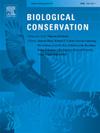Functional recovery of tropical forests: The role of restoration methods and environmental conditions
IF 4.4
1区 环境科学与生态学
Q1 BIODIVERSITY CONSERVATION
引用次数: 0
Abstract
Forest and landscape restoration strategies influence the recovery of plant functional traits, which in turn shape ecosystem processes. To understand how traits respond to restoration and environmental conditions, we assessed the functional recovery of three forest restoration types in Brazil's Atlantic Forest: natural regeneration, high-diversity restoration plantations (20–60 species), and unmanaged tree monocultures. Across 285 plots aged 1–76 years, we quantified seven leaf and stem traits for over 500 species. For each plot, we calculated community mean trait values and three functional diversity indices. The three restoration types showed contrasting successional patterns. Natural regeneration and restoration plantations shifted from acquisitive to conservative resource-use strategies with site age, while monocultures moved in the opposite direction. Restoration plantations exhibited the highest functional richness. Soil conditions (sand content and sum of bases) influenced trait composition and diversity, whereas climate and landscape context had smaller effects. In 20-year old sites, most traits in natural regeneration and restoration plantations approached 90 % of forest remnants values. In contrast, unmanaged monocultures recovered slowly, with only half of the traits reaching this threshold in 40-year old sites. Our findings show that restoration methods and site conditions jointly shape functional recovery. Natural regeneration tends to align with forest remnant traits, restoration plantations speed up early recovery but may diverge over time, and monocultures require active interventions to enhance outcomes. Recognizing these functional trajectories is key to improving biodiversity conservation and ecosystem resilience in tropical forest restoration.
热带森林的功能恢复:恢复方法和环境条件的作用
森林和景观恢复策略影响植物功能性状的恢复,进而影响生态系统过程。为了了解特征对恢复和环境条件的响应,我们评估了巴西大西洋森林三种森林恢复类型的功能恢复:自然更新、高多样性恢复人工林(20-60种)和无管理的树木单一栽培。在285个1 ~ 76年的样地中,我们对500多个物种的7个叶和茎性状进行了量化。对于每个样地,我们计算群落平均性状值和3个功能多样性指数。三种恢复类型表现出不同的演替格局。随着立地年龄的增长,自然更新和恢复人工林的资源利用策略从获取型向保守型转变,而单一栽培则相反。恢复人工林功能丰富度最高。土壤条件(含沙量和碱基数量)对性状组成和多样性有影响,而气候和景观背景的影响较小。在20年的立地中,自然更新和恢复人工林的大部分性状接近森林残留值的90%。相比之下,未经管理的单一栽培恢复缓慢,在40年的遗址中,只有一半的性状达到了这个阈值。我们的研究结果表明,修复方法和场地条件共同决定了功能的恢复。自然更新倾向于与森林遗迹特征保持一致,恢复人工林加速了早期恢复,但可能随着时间的推移而分化,单一栽培需要积极干预以提高结果。认识到这些功能轨迹是改善热带森林恢复中生物多样性保护和生态系统恢复能力的关键。
本文章由计算机程序翻译,如有差异,请以英文原文为准。
求助全文
约1分钟内获得全文
求助全文
来源期刊

Biological Conservation
环境科学-环境科学
CiteScore
10.20
自引率
3.40%
发文量
295
审稿时长
61 days
期刊介绍:
Biological Conservation is an international leading journal in the discipline of conservation biology. The journal publishes articles spanning a diverse range of fields that contribute to the biological, sociological, and economic dimensions of conservation and natural resource management. The primary aim of Biological Conservation is the publication of high-quality papers that advance the science and practice of conservation, or which demonstrate the application of conservation principles for natural resource management and policy. Therefore it will be of interest to a broad international readership.
 求助内容:
求助内容: 应助结果提醒方式:
应助结果提醒方式:


